Strategic Marketing for Yummy Food in Romania
VerifiedAdded on 2023/03/20
|13
|4619
|56
AI Summary
This document provides a strategic marketing plan for opening a food chain called 'Yummy Food' in Romania, targeting the service industry and delivering food to nurseries. It includes a PESTEL analysis of Romania, recommendations for market entry modes, market segmentation, and target market strategy.
Contribute Materials
Your contribution can guide someone’s learning journey. Share your
documents today.
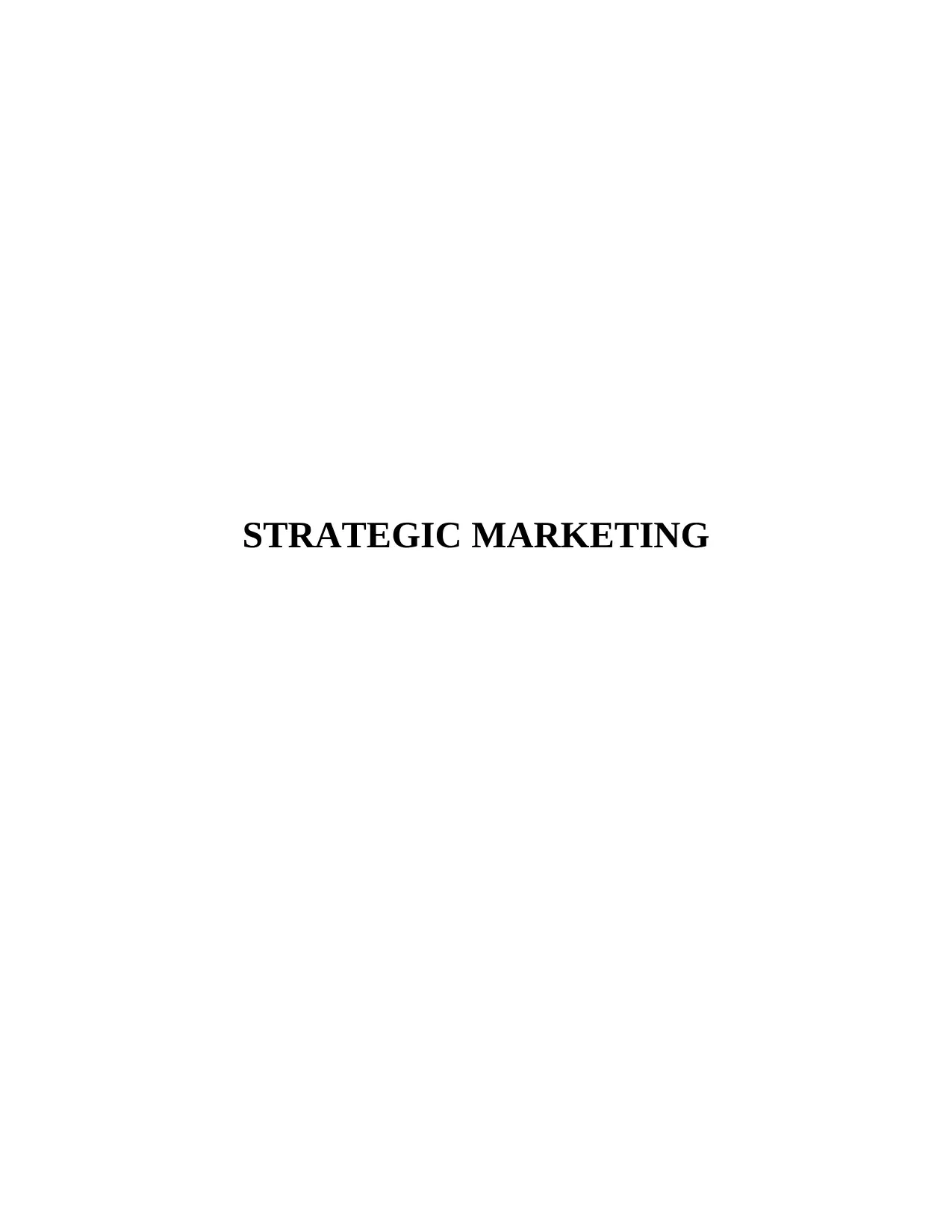
STRATEGIC MARKETING
Secure Best Marks with AI Grader
Need help grading? Try our AI Grader for instant feedback on your assignments.
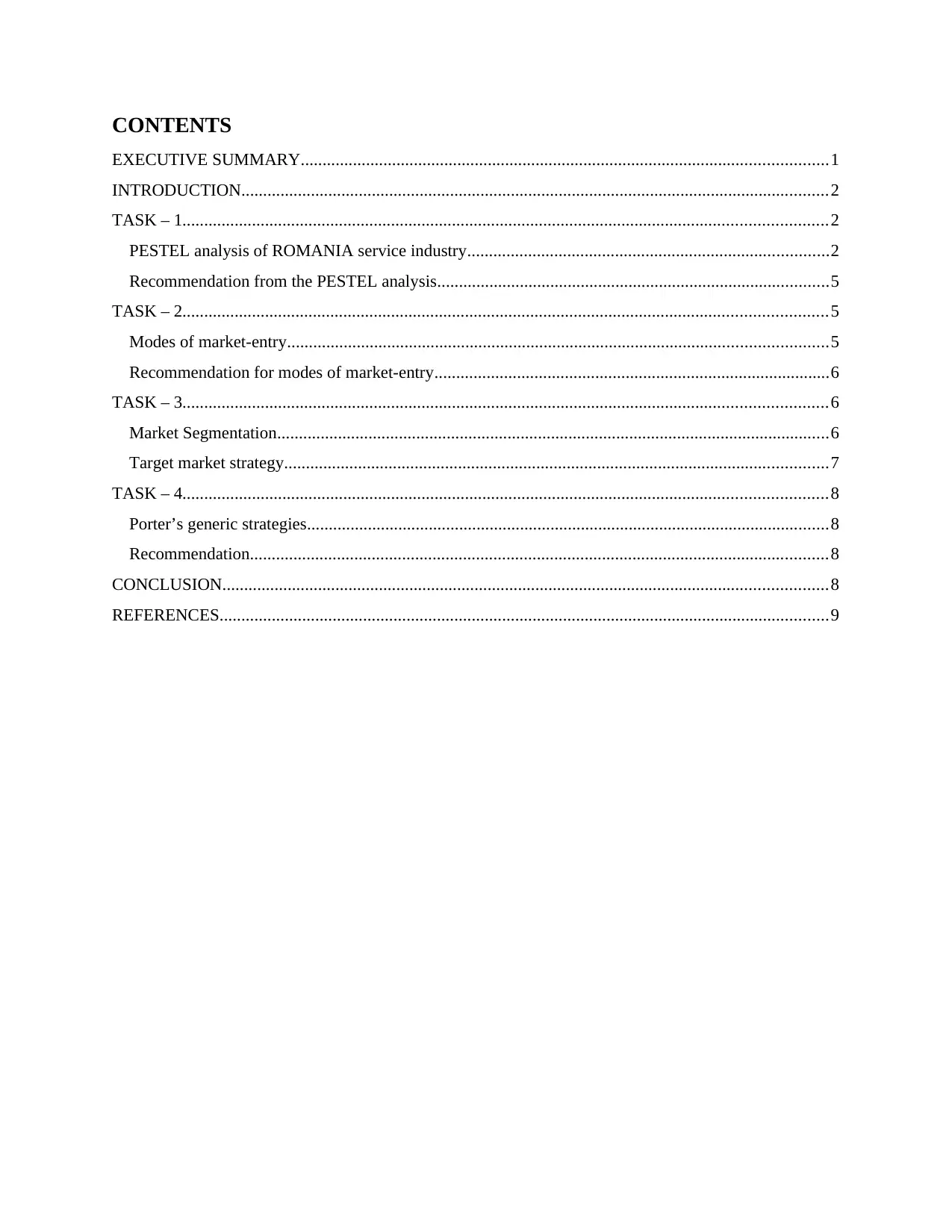
CONTENTS
EXECUTIVE SUMMARY.........................................................................................................................1
INTRODUCTION.......................................................................................................................................2
TASK – 1....................................................................................................................................................2
PESTEL analysis of ROMANIA service industry...................................................................................2
Recommendation from the PESTEL analysis..........................................................................................5
TASK – 2....................................................................................................................................................5
Modes of market-entry............................................................................................................................5
Recommendation for modes of market-entry...........................................................................................6
TASK – 3....................................................................................................................................................6
Market Segmentation...............................................................................................................................6
Target market strategy.............................................................................................................................7
TASK – 4....................................................................................................................................................8
Porter’s generic strategies........................................................................................................................8
Recommendation.....................................................................................................................................8
CONCLUSION...........................................................................................................................................8
REFERENCES............................................................................................................................................9
EXECUTIVE SUMMARY.........................................................................................................................1
INTRODUCTION.......................................................................................................................................2
TASK – 1....................................................................................................................................................2
PESTEL analysis of ROMANIA service industry...................................................................................2
Recommendation from the PESTEL analysis..........................................................................................5
TASK – 2....................................................................................................................................................5
Modes of market-entry............................................................................................................................5
Recommendation for modes of market-entry...........................................................................................6
TASK – 3....................................................................................................................................................6
Market Segmentation...............................................................................................................................6
Target market strategy.............................................................................................................................7
TASK – 4....................................................................................................................................................8
Porter’s generic strategies........................................................................................................................8
Recommendation.....................................................................................................................................8
CONCLUSION...........................................................................................................................................8
REFERENCES............................................................................................................................................9
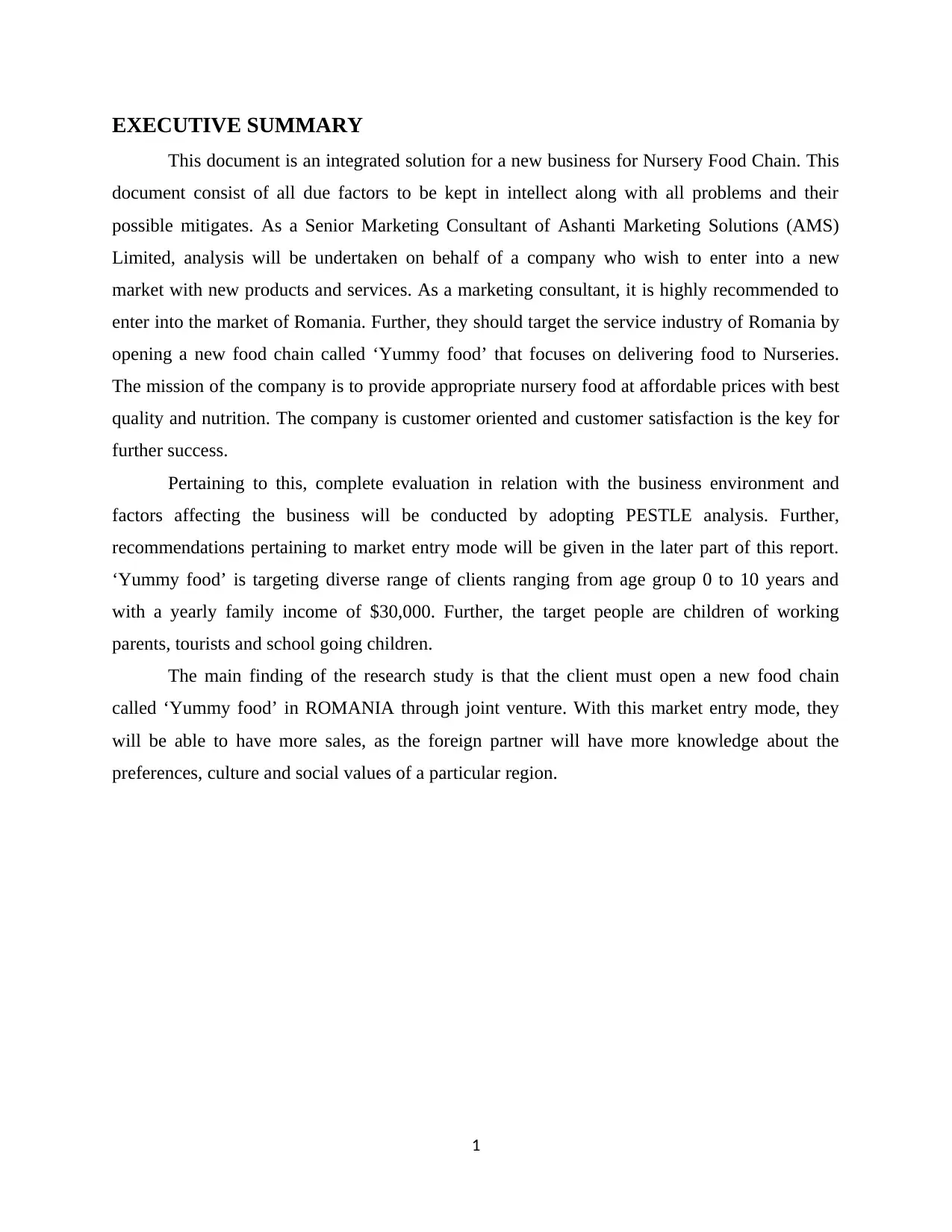
EXECUTIVE SUMMARY
This document is an integrated solution for a new business for Nursery Food Chain. This
document consist of all due factors to be kept in intellect along with all problems and their
possible mitigates. As a Senior Marketing Consultant of Ashanti Marketing Solutions (AMS)
Limited, analysis will be undertaken on behalf of a company who wish to enter into a new
market with new products and services. As a marketing consultant, it is highly recommended to
enter into the market of Romania. Further, they should target the service industry of Romania by
opening a new food chain called ‘Yummy food’ that focuses on delivering food to Nurseries.
The mission of the company is to provide appropriate nursery food at affordable prices with best
quality and nutrition. The company is customer oriented and customer satisfaction is the key for
further success.
Pertaining to this, complete evaluation in relation with the business environment and
factors affecting the business will be conducted by adopting PESTLE analysis. Further,
recommendations pertaining to market entry mode will be given in the later part of this report.
‘Yummy food’ is targeting diverse range of clients ranging from age group 0 to 10 years and
with a yearly family income of $30,000. Further, the target people are children of working
parents, tourists and school going children.
The main finding of the research study is that the client must open a new food chain
called ‘Yummy food’ in ROMANIA through joint venture. With this market entry mode, they
will be able to have more sales, as the foreign partner will have more knowledge about the
preferences, culture and social values of a particular region.
1
This document is an integrated solution for a new business for Nursery Food Chain. This
document consist of all due factors to be kept in intellect along with all problems and their
possible mitigates. As a Senior Marketing Consultant of Ashanti Marketing Solutions (AMS)
Limited, analysis will be undertaken on behalf of a company who wish to enter into a new
market with new products and services. As a marketing consultant, it is highly recommended to
enter into the market of Romania. Further, they should target the service industry of Romania by
opening a new food chain called ‘Yummy food’ that focuses on delivering food to Nurseries.
The mission of the company is to provide appropriate nursery food at affordable prices with best
quality and nutrition. The company is customer oriented and customer satisfaction is the key for
further success.
Pertaining to this, complete evaluation in relation with the business environment and
factors affecting the business will be conducted by adopting PESTLE analysis. Further,
recommendations pertaining to market entry mode will be given in the later part of this report.
‘Yummy food’ is targeting diverse range of clients ranging from age group 0 to 10 years and
with a yearly family income of $30,000. Further, the target people are children of working
parents, tourists and school going children.
The main finding of the research study is that the client must open a new food chain
called ‘Yummy food’ in ROMANIA through joint venture. With this market entry mode, they
will be able to have more sales, as the foreign partner will have more knowledge about the
preferences, culture and social values of a particular region.
1

INTRODUCTION
In the present global scenario, for almost every organization, international business has
become the core subject in order to carry out their business. The hottest topic among the business
organizations nowadays is internationalizing their business. Because of the increasing pace of
technological advancement, companies are steeping towards exploring the global market to
achieve larger market share and high revenue (Schools and Whittington, 2008). However, this
could take place with strategic planning and marketing. It is a link between the organizations and
the environment and takes into account the constantly changing trends and factors impacting the
business. Pertaining to this, the present research study is also about the strategic marketing and
its tools and how it helps the business to sustain and achieve the path of glory and success.
As a Senior Marketing Consultant of Ashanti Marketing Solutions (AMS) Limited,
analysis will be undertaken on behalf of a company who wish to enter into a new market with
new products and services. Our client is obscure and need solution in regards with which market
to enter and what kinds of services and products to be offered. They even want suggestion
regarding which country to enter and will be best suitable for their new services. Thus, the main
aim of the present research study is to offer recommendation to the client as to which country to
offer by carrying out macro-environmental analysis. Further, it will evaluate various
opportunities and threats the company will face in the new market.
Since the company wants to enter into a new country, as a marketing consultant, it is
highly recommended to enter into the market of Romania. Further, they should target the service
industry of Romania by opening a new food chain called ‘Yummy food’ that focuses on
delivering food to Nurseries. Pertaining to this, complete evaluation in relation with the business
environment and factors affecting the business will be conducted. Further, various suggestions in
regards with the modes of entering into the market of Romania will be given in the later part of
the report. No business can succeed and proceed further without segmentation and targeting and
thus, thorough analysis of these concepts will be undertaken so that the potential target market
for the client can be evaluated.
TASK – 1
PESTEL analysis of ROMANIA
2
In the present global scenario, for almost every organization, international business has
become the core subject in order to carry out their business. The hottest topic among the business
organizations nowadays is internationalizing their business. Because of the increasing pace of
technological advancement, companies are steeping towards exploring the global market to
achieve larger market share and high revenue (Schools and Whittington, 2008). However, this
could take place with strategic planning and marketing. It is a link between the organizations and
the environment and takes into account the constantly changing trends and factors impacting the
business. Pertaining to this, the present research study is also about the strategic marketing and
its tools and how it helps the business to sustain and achieve the path of glory and success.
As a Senior Marketing Consultant of Ashanti Marketing Solutions (AMS) Limited,
analysis will be undertaken on behalf of a company who wish to enter into a new market with
new products and services. Our client is obscure and need solution in regards with which market
to enter and what kinds of services and products to be offered. They even want suggestion
regarding which country to enter and will be best suitable for their new services. Thus, the main
aim of the present research study is to offer recommendation to the client as to which country to
offer by carrying out macro-environmental analysis. Further, it will evaluate various
opportunities and threats the company will face in the new market.
Since the company wants to enter into a new country, as a marketing consultant, it is
highly recommended to enter into the market of Romania. Further, they should target the service
industry of Romania by opening a new food chain called ‘Yummy food’ that focuses on
delivering food to Nurseries. Pertaining to this, complete evaluation in relation with the business
environment and factors affecting the business will be conducted. Further, various suggestions in
regards with the modes of entering into the market of Romania will be given in the later part of
the report. No business can succeed and proceed further without segmentation and targeting and
thus, thorough analysis of these concepts will be undertaken so that the potential target market
for the client can be evaluated.
TASK – 1
PESTEL analysis of ROMANIA
2
Secure Best Marks with AI Grader
Need help grading? Try our AI Grader for instant feedback on your assignments.
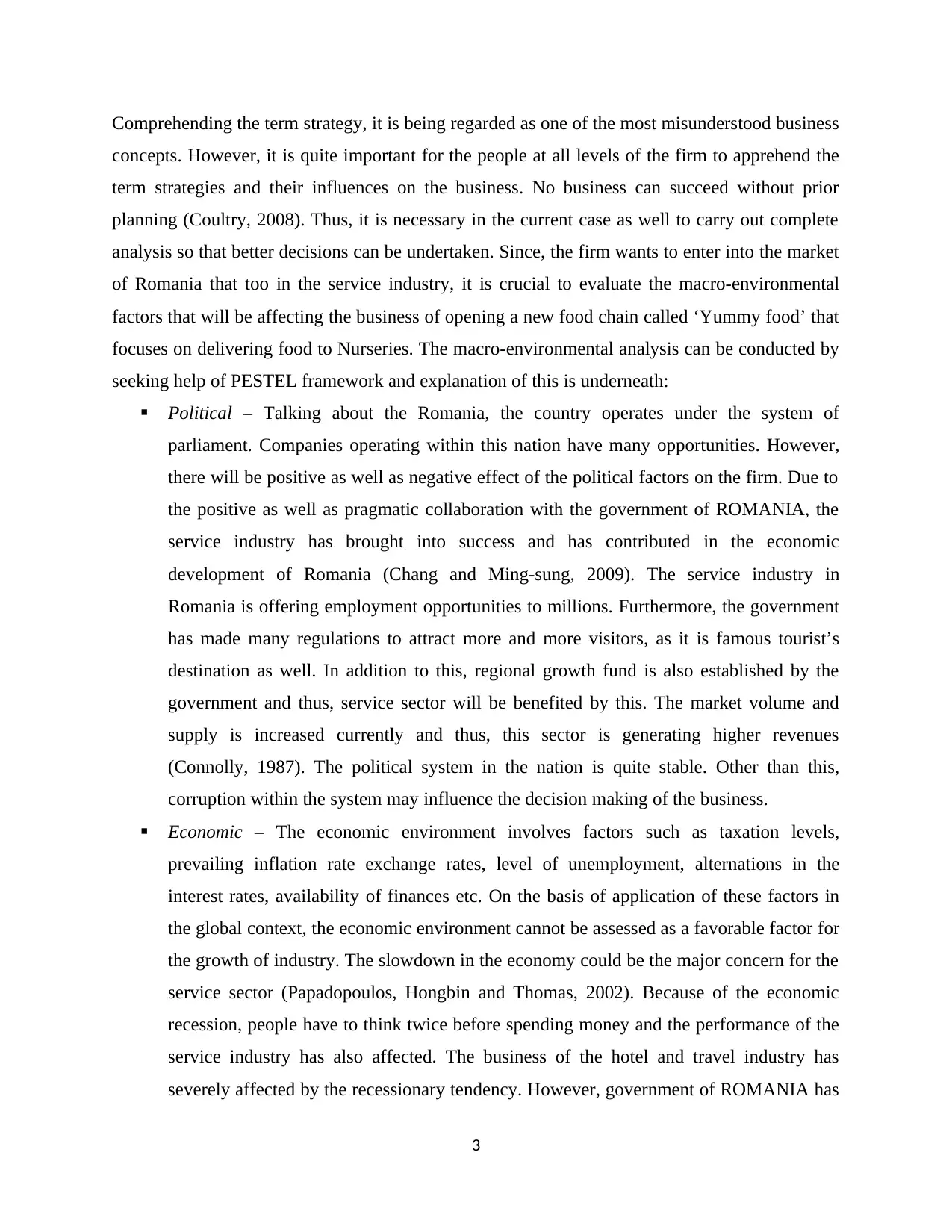
Comprehending the term strategy, it is being regarded as one of the most misunderstood business
concepts. However, it is quite important for the people at all levels of the firm to apprehend the
term strategies and their influences on the business. No business can succeed without prior
planning (Coultry, 2008). Thus, it is necessary in the current case as well to carry out complete
analysis so that better decisions can be undertaken. Since, the firm wants to enter into the market
of Romania that too in the service industry, it is crucial to evaluate the macro-environmental
factors that will be affecting the business of opening a new food chain called ‘Yummy food’ that
focuses on delivering food to Nurseries. The macro-environmental analysis can be conducted by
seeking help of PESTEL framework and explanation of this is underneath:
Political – Talking about the Romania, the country operates under the system of
parliament. Companies operating within this nation have many opportunities. However,
there will be positive as well as negative effect of the political factors on the firm. Due to
the positive as well as pragmatic collaboration with the government of ROMANIA, the
service industry has brought into success and has contributed in the economic
development of Romania (Chang and Ming-sung, 2009). The service industry in
Romania is offering employment opportunities to millions. Furthermore, the government
has made many regulations to attract more and more visitors, as it is famous tourist’s
destination as well. In addition to this, regional growth fund is also established by the
government and thus, service sector will be benefited by this. The market volume and
supply is increased currently and thus, this sector is generating higher revenues
(Connolly, 1987). The political system in the nation is quite stable. Other than this,
corruption within the system may influence the decision making of the business.
Economic – The economic environment involves factors such as taxation levels,
prevailing inflation rate exchange rates, level of unemployment, alternations in the
interest rates, availability of finances etc. On the basis of application of these factors in
the global context, the economic environment cannot be assessed as a favorable factor for
the growth of industry. The slowdown in the economy could be the major concern for the
service sector (Papadopoulos, Hongbin and Thomas, 2002). Because of the economic
recession, people have to think twice before spending money and the performance of the
service industry has also affected. The business of the hotel and travel industry has
severely affected by the recessionary tendency. However, government of ROMANIA has
3
concepts. However, it is quite important for the people at all levels of the firm to apprehend the
term strategies and their influences on the business. No business can succeed without prior
planning (Coultry, 2008). Thus, it is necessary in the current case as well to carry out complete
analysis so that better decisions can be undertaken. Since, the firm wants to enter into the market
of Romania that too in the service industry, it is crucial to evaluate the macro-environmental
factors that will be affecting the business of opening a new food chain called ‘Yummy food’ that
focuses on delivering food to Nurseries. The macro-environmental analysis can be conducted by
seeking help of PESTEL framework and explanation of this is underneath:
Political – Talking about the Romania, the country operates under the system of
parliament. Companies operating within this nation have many opportunities. However,
there will be positive as well as negative effect of the political factors on the firm. Due to
the positive as well as pragmatic collaboration with the government of ROMANIA, the
service industry has brought into success and has contributed in the economic
development of Romania (Chang and Ming-sung, 2009). The service industry in
Romania is offering employment opportunities to millions. Furthermore, the government
has made many regulations to attract more and more visitors, as it is famous tourist’s
destination as well. In addition to this, regional growth fund is also established by the
government and thus, service sector will be benefited by this. The market volume and
supply is increased currently and thus, this sector is generating higher revenues
(Connolly, 1987). The political system in the nation is quite stable. Other than this,
corruption within the system may influence the decision making of the business.
Economic – The economic environment involves factors such as taxation levels,
prevailing inflation rate exchange rates, level of unemployment, alternations in the
interest rates, availability of finances etc. On the basis of application of these factors in
the global context, the economic environment cannot be assessed as a favorable factor for
the growth of industry. The slowdown in the economy could be the major concern for the
service sector (Papadopoulos, Hongbin and Thomas, 2002). Because of the economic
recession, people have to think twice before spending money and the performance of the
service industry has also affected. The business of the hotel and travel industry has
severely affected by the recessionary tendency. However, government of ROMANIA has
3
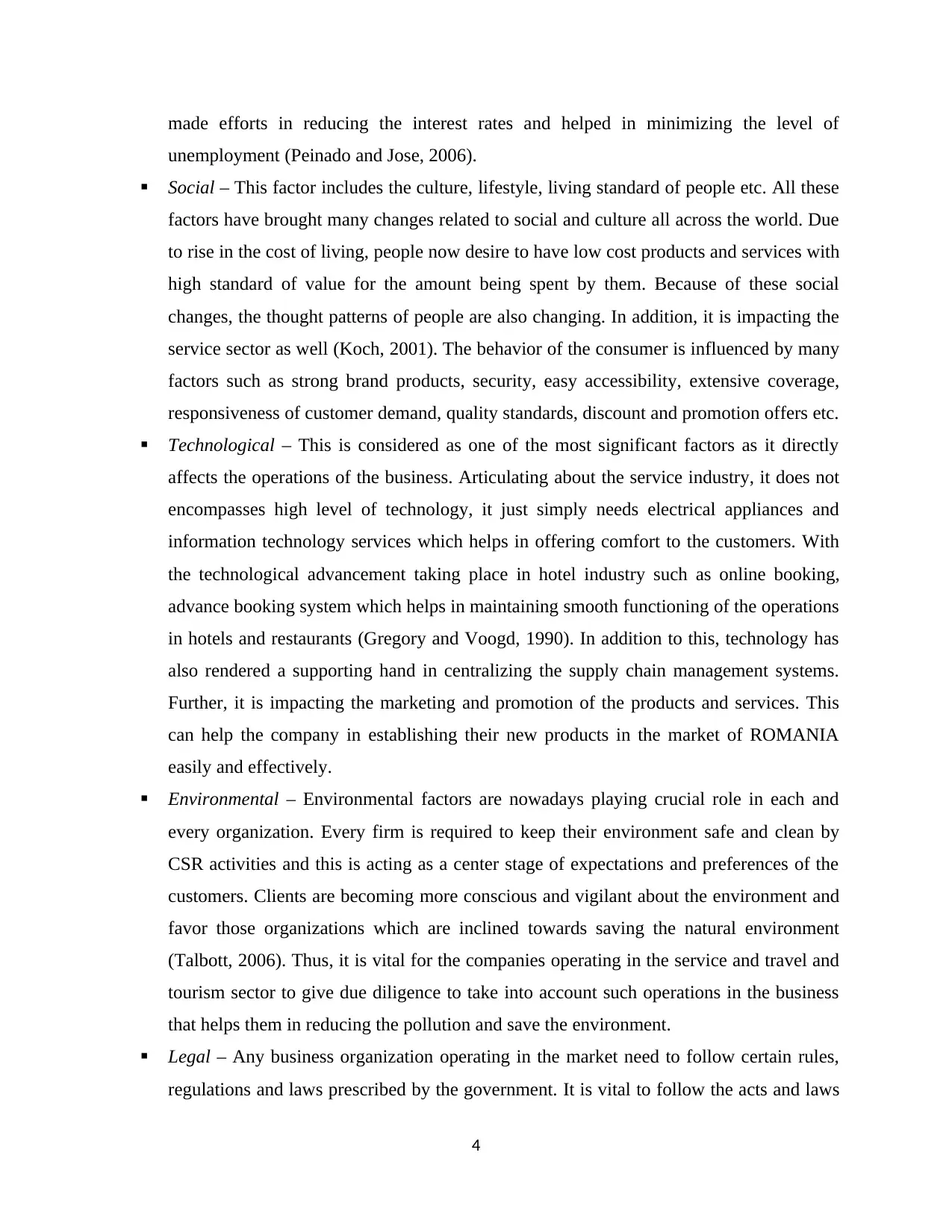
made efforts in reducing the interest rates and helped in minimizing the level of
unemployment (Peinado and Jose, 2006).
Social – This factor includes the culture, lifestyle, living standard of people etc. All these
factors have brought many changes related to social and culture all across the world. Due
to rise in the cost of living, people now desire to have low cost products and services with
high standard of value for the amount being spent by them. Because of these social
changes, the thought patterns of people are also changing. In addition, it is impacting the
service sector as well (Koch, 2001). The behavior of the consumer is influenced by many
factors such as strong brand products, security, easy accessibility, extensive coverage,
responsiveness of customer demand, quality standards, discount and promotion offers etc.
Technological – This is considered as one of the most significant factors as it directly
affects the operations of the business. Articulating about the service industry, it does not
encompasses high level of technology, it just simply needs electrical appliances and
information technology services which helps in offering comfort to the customers. With
the technological advancement taking place in hotel industry such as online booking,
advance booking system which helps in maintaining smooth functioning of the operations
in hotels and restaurants (Gregory and Voogd, 1990). In addition to this, technology has
also rendered a supporting hand in centralizing the supply chain management systems.
Further, it is impacting the marketing and promotion of the products and services. This
can help the company in establishing their new products in the market of ROMANIA
easily and effectively.
Environmental – Environmental factors are nowadays playing crucial role in each and
every organization. Every firm is required to keep their environment safe and clean by
CSR activities and this is acting as a center stage of expectations and preferences of the
customers. Clients are becoming more conscious and vigilant about the environment and
favor those organizations which are inclined towards saving the natural environment
(Talbott, 2006). Thus, it is vital for the companies operating in the service and travel and
tourism sector to give due diligence to take into account such operations in the business
that helps them in reducing the pollution and save the environment.
Legal – Any business organization operating in the market need to follow certain rules,
regulations and laws prescribed by the government. It is vital to follow the acts and laws
4
unemployment (Peinado and Jose, 2006).
Social – This factor includes the culture, lifestyle, living standard of people etc. All these
factors have brought many changes related to social and culture all across the world. Due
to rise in the cost of living, people now desire to have low cost products and services with
high standard of value for the amount being spent by them. Because of these social
changes, the thought patterns of people are also changing. In addition, it is impacting the
service sector as well (Koch, 2001). The behavior of the consumer is influenced by many
factors such as strong brand products, security, easy accessibility, extensive coverage,
responsiveness of customer demand, quality standards, discount and promotion offers etc.
Technological – This is considered as one of the most significant factors as it directly
affects the operations of the business. Articulating about the service industry, it does not
encompasses high level of technology, it just simply needs electrical appliances and
information technology services which helps in offering comfort to the customers. With
the technological advancement taking place in hotel industry such as online booking,
advance booking system which helps in maintaining smooth functioning of the operations
in hotels and restaurants (Gregory and Voogd, 1990). In addition to this, technology has
also rendered a supporting hand in centralizing the supply chain management systems.
Further, it is impacting the marketing and promotion of the products and services. This
can help the company in establishing their new products in the market of ROMANIA
easily and effectively.
Environmental – Environmental factors are nowadays playing crucial role in each and
every organization. Every firm is required to keep their environment safe and clean by
CSR activities and this is acting as a center stage of expectations and preferences of the
customers. Clients are becoming more conscious and vigilant about the environment and
favor those organizations which are inclined towards saving the natural environment
(Talbott, 2006). Thus, it is vital for the companies operating in the service and travel and
tourism sector to give due diligence to take into account such operations in the business
that helps them in reducing the pollution and save the environment.
Legal – Any business organization operating in the market need to follow certain rules,
regulations and laws prescribed by the government. It is vital to follow the acts and laws
4
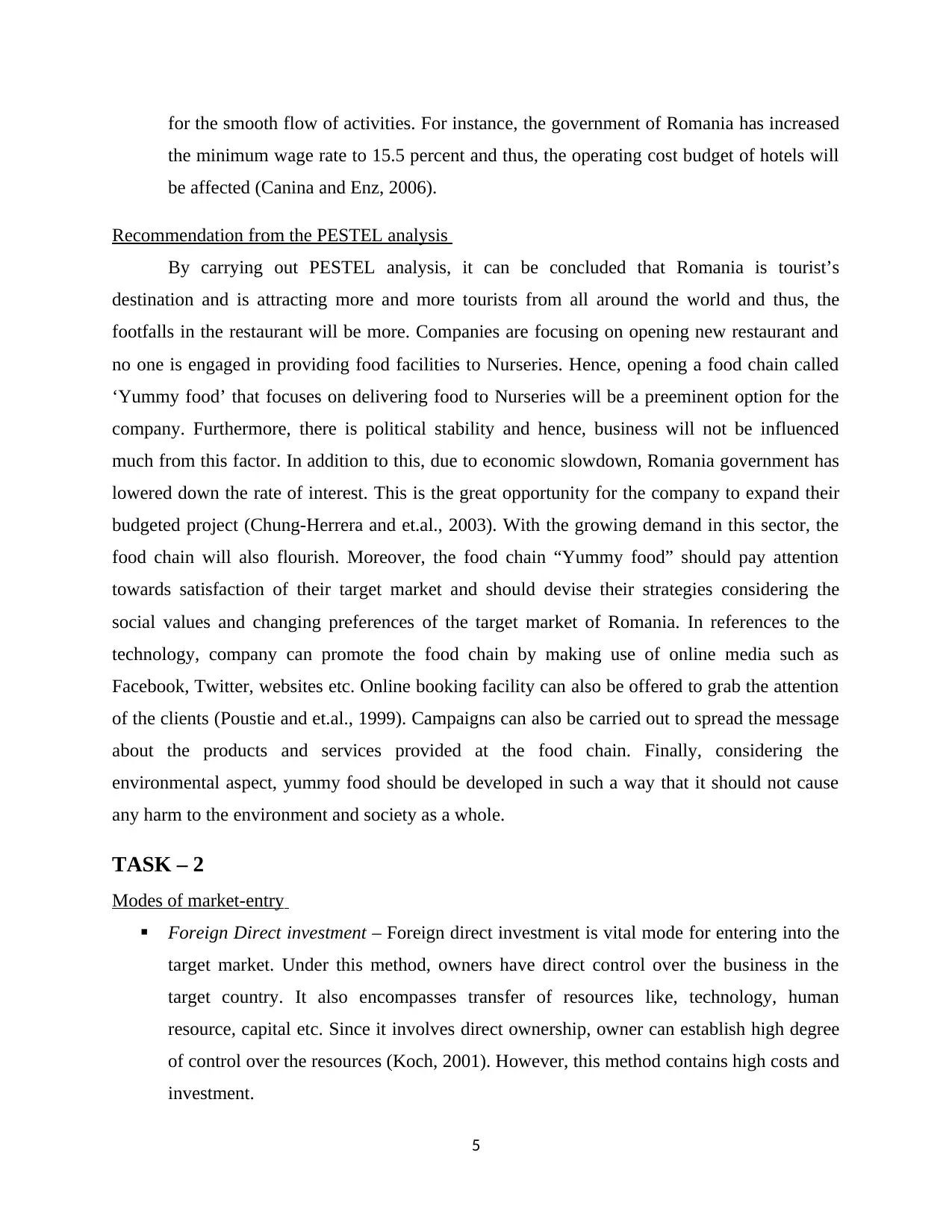
for the smooth flow of activities. For instance, the government of Romania has increased
the minimum wage rate to 15.5 percent and thus, the operating cost budget of hotels will
be affected (Canina and Enz, 2006).
Recommendation from the PESTEL analysis
By carrying out PESTEL analysis, it can be concluded that Romania is tourist’s
destination and is attracting more and more tourists from all around the world and thus, the
footfalls in the restaurant will be more. Companies are focusing on opening new restaurant and
no one is engaged in providing food facilities to Nurseries. Hence, opening a food chain called
‘Yummy food’ that focuses on delivering food to Nurseries will be a preeminent option for the
company. Furthermore, there is political stability and hence, business will not be influenced
much from this factor. In addition to this, due to economic slowdown, Romania government has
lowered down the rate of interest. This is the great opportunity for the company to expand their
budgeted project (Chung-Herrera and et.al., 2003). With the growing demand in this sector, the
food chain will also flourish. Moreover, the food chain “Yummy food” should pay attention
towards satisfaction of their target market and should devise their strategies considering the
social values and changing preferences of the target market of Romania. In references to the
technology, company can promote the food chain by making use of online media such as
Facebook, Twitter, websites etc. Online booking facility can also be offered to grab the attention
of the clients (Poustie and et.al., 1999). Campaigns can also be carried out to spread the message
about the products and services provided at the food chain. Finally, considering the
environmental aspect, yummy food should be developed in such a way that it should not cause
any harm to the environment and society as a whole.
TASK – 2
Modes of market-entry
Foreign Direct investment – Foreign direct investment is vital mode for entering into the
target market. Under this method, owners have direct control over the business in the
target country. It also encompasses transfer of resources like, technology, human
resource, capital etc. Since it involves direct ownership, owner can establish high degree
of control over the resources (Koch, 2001). However, this method contains high costs and
investment.
5
the minimum wage rate to 15.5 percent and thus, the operating cost budget of hotels will
be affected (Canina and Enz, 2006).
Recommendation from the PESTEL analysis
By carrying out PESTEL analysis, it can be concluded that Romania is tourist’s
destination and is attracting more and more tourists from all around the world and thus, the
footfalls in the restaurant will be more. Companies are focusing on opening new restaurant and
no one is engaged in providing food facilities to Nurseries. Hence, opening a food chain called
‘Yummy food’ that focuses on delivering food to Nurseries will be a preeminent option for the
company. Furthermore, there is political stability and hence, business will not be influenced
much from this factor. In addition to this, due to economic slowdown, Romania government has
lowered down the rate of interest. This is the great opportunity for the company to expand their
budgeted project (Chung-Herrera and et.al., 2003). With the growing demand in this sector, the
food chain will also flourish. Moreover, the food chain “Yummy food” should pay attention
towards satisfaction of their target market and should devise their strategies considering the
social values and changing preferences of the target market of Romania. In references to the
technology, company can promote the food chain by making use of online media such as
Facebook, Twitter, websites etc. Online booking facility can also be offered to grab the attention
of the clients (Poustie and et.al., 1999). Campaigns can also be carried out to spread the message
about the products and services provided at the food chain. Finally, considering the
environmental aspect, yummy food should be developed in such a way that it should not cause
any harm to the environment and society as a whole.
TASK – 2
Modes of market-entry
Foreign Direct investment – Foreign direct investment is vital mode for entering into the
target market. Under this method, owners have direct control over the business in the
target country. It also encompasses transfer of resources like, technology, human
resource, capital etc. Since it involves direct ownership, owner can establish high degree
of control over the resources (Koch, 2001). However, this method contains high costs and
investment.
5
Paraphrase This Document
Need a fresh take? Get an instant paraphrase of this document with our AI Paraphraser
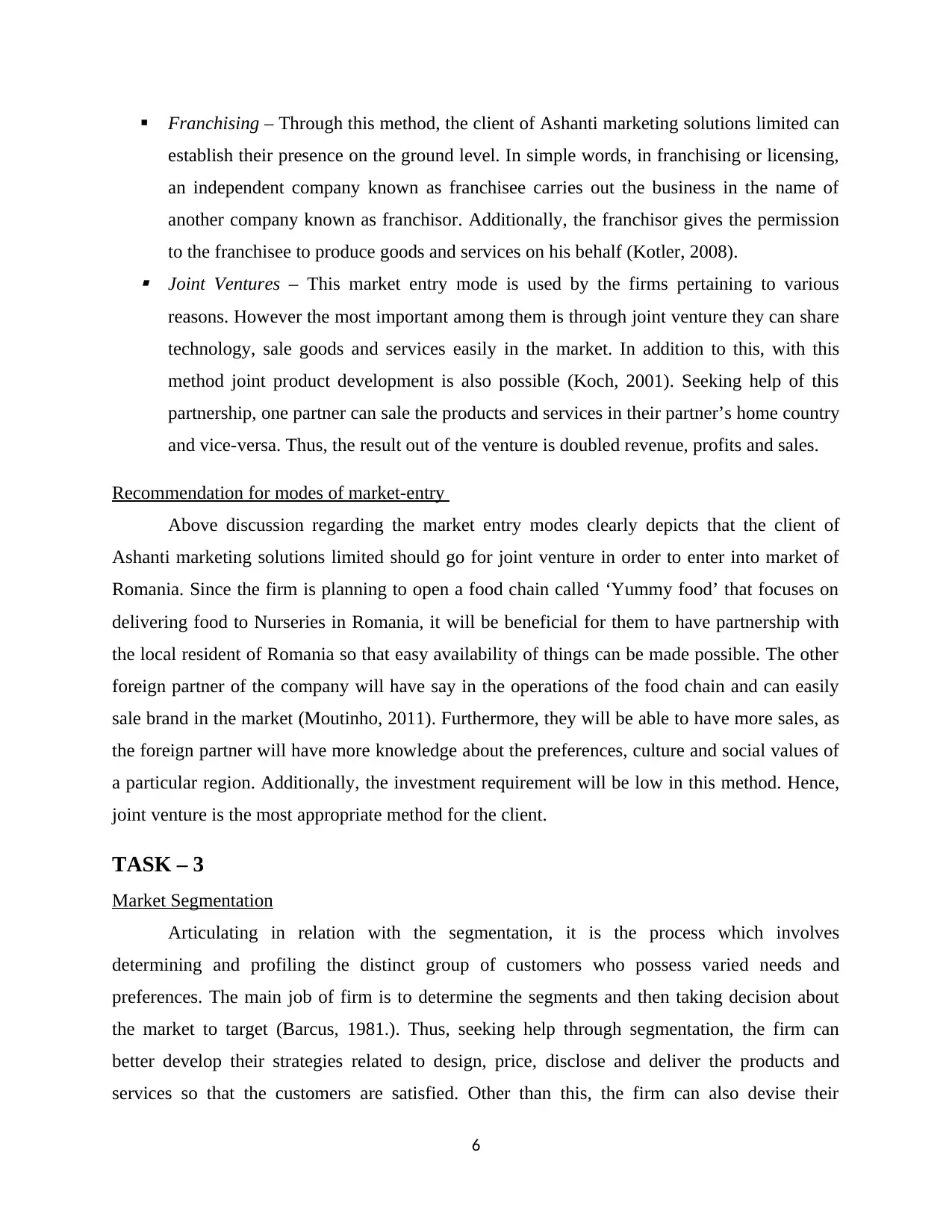
Franchising – Through this method, the client of Ashanti marketing solutions limited can
establish their presence on the ground level. In simple words, in franchising or licensing,
an independent company known as franchisee carries out the business in the name of
another company known as franchisor. Additionally, the franchisor gives the permission
to the franchisee to produce goods and services on his behalf (Kotler, 2008). Joint Ventures – This market entry mode is used by the firms pertaining to various
reasons. However the most important among them is through joint venture they can share
technology, sale goods and services easily in the market. In addition to this, with this
method joint product development is also possible (Koch, 2001). Seeking help of this
partnership, one partner can sale the products and services in their partner’s home country
and vice-versa. Thus, the result out of the venture is doubled revenue, profits and sales.
Recommendation for modes of market-entry
Above discussion regarding the market entry modes clearly depicts that the client of
Ashanti marketing solutions limited should go for joint venture in order to enter into market of
Romania. Since the firm is planning to open a food chain called ‘Yummy food’ that focuses on
delivering food to Nurseries in Romania, it will be beneficial for them to have partnership with
the local resident of Romania so that easy availability of things can be made possible. The other
foreign partner of the company will have say in the operations of the food chain and can easily
sale brand in the market (Moutinho, 2011). Furthermore, they will be able to have more sales, as
the foreign partner will have more knowledge about the preferences, culture and social values of
a particular region. Additionally, the investment requirement will be low in this method. Hence,
joint venture is the most appropriate method for the client.
TASK – 3
Market Segmentation
Articulating in relation with the segmentation, it is the process which involves
determining and profiling the distinct group of customers who possess varied needs and
preferences. The main job of firm is to determine the segments and then taking decision about
the market to target (Barcus, 1981.). Thus, seeking help through segmentation, the firm can
better develop their strategies related to design, price, disclose and deliver the products and
services so that the customers are satisfied. Other than this, the firm can also devise their
6
establish their presence on the ground level. In simple words, in franchising or licensing,
an independent company known as franchisee carries out the business in the name of
another company known as franchisor. Additionally, the franchisor gives the permission
to the franchisee to produce goods and services on his behalf (Kotler, 2008). Joint Ventures – This market entry mode is used by the firms pertaining to various
reasons. However the most important among them is through joint venture they can share
technology, sale goods and services easily in the market. In addition to this, with this
method joint product development is also possible (Koch, 2001). Seeking help of this
partnership, one partner can sale the products and services in their partner’s home country
and vice-versa. Thus, the result out of the venture is doubled revenue, profits and sales.
Recommendation for modes of market-entry
Above discussion regarding the market entry modes clearly depicts that the client of
Ashanti marketing solutions limited should go for joint venture in order to enter into market of
Romania. Since the firm is planning to open a food chain called ‘Yummy food’ that focuses on
delivering food to Nurseries in Romania, it will be beneficial for them to have partnership with
the local resident of Romania so that easy availability of things can be made possible. The other
foreign partner of the company will have say in the operations of the food chain and can easily
sale brand in the market (Moutinho, 2011). Furthermore, they will be able to have more sales, as
the foreign partner will have more knowledge about the preferences, culture and social values of
a particular region. Additionally, the investment requirement will be low in this method. Hence,
joint venture is the most appropriate method for the client.
TASK – 3
Market Segmentation
Articulating in relation with the segmentation, it is the process which involves
determining and profiling the distinct group of customers who possess varied needs and
preferences. The main job of firm is to determine the segments and then taking decision about
the market to target (Barcus, 1981.). Thus, seeking help through segmentation, the firm can
better develop their strategies related to design, price, disclose and deliver the products and
services so that the customers are satisfied. Other than this, the firm can also devise their
6
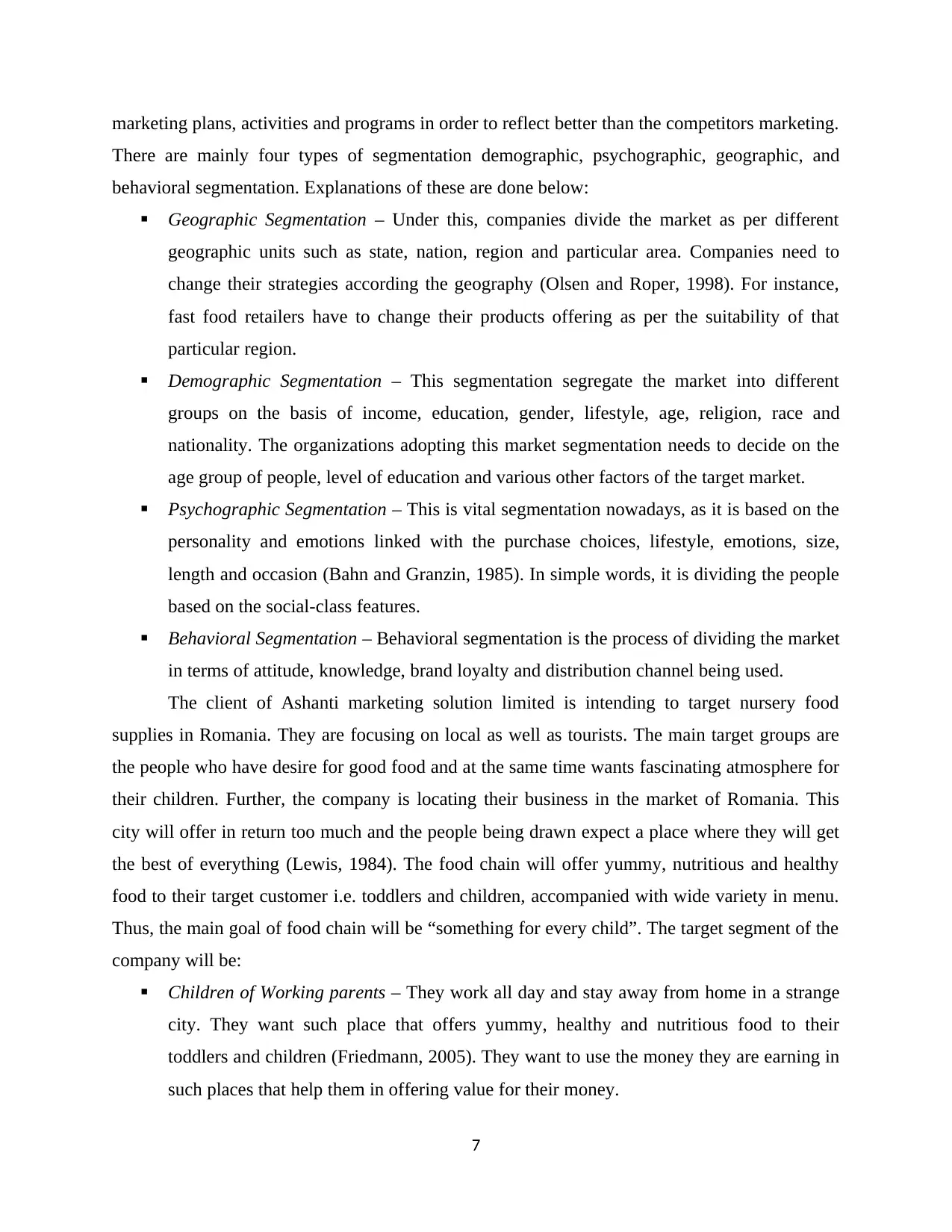
marketing plans, activities and programs in order to reflect better than the competitors marketing.
There are mainly four types of segmentation demographic, psychographic, geographic, and
behavioral segmentation. Explanations of these are done below:
Geographic Segmentation – Under this, companies divide the market as per different
geographic units such as state, nation, region and particular area. Companies need to
change their strategies according the geography (Olsen and Roper, 1998). For instance,
fast food retailers have to change their products offering as per the suitability of that
particular region.
Demographic Segmentation – This segmentation segregate the market into different
groups on the basis of income, education, gender, lifestyle, age, religion, race and
nationality. The organizations adopting this market segmentation needs to decide on the
age group of people, level of education and various other factors of the target market.
Psychographic Segmentation – This is vital segmentation nowadays, as it is based on the
personality and emotions linked with the purchase choices, lifestyle, emotions, size,
length and occasion (Bahn and Granzin, 1985). In simple words, it is dividing the people
based on the social-class features.
Behavioral Segmentation – Behavioral segmentation is the process of dividing the market
in terms of attitude, knowledge, brand loyalty and distribution channel being used.
The client of Ashanti marketing solution limited is intending to target nursery food
supplies in Romania. They are focusing on local as well as tourists. The main target groups are
the people who have desire for good food and at the same time wants fascinating atmosphere for
their children. Further, the company is locating their business in the market of Romania. This
city will offer in return too much and the people being drawn expect a place where they will get
the best of everything (Lewis, 1984). The food chain will offer yummy, nutritious and healthy
food to their target customer i.e. toddlers and children, accompanied with wide variety in menu.
Thus, the main goal of food chain will be “something for every child”. The target segment of the
company will be:
Children of Working parents – They work all day and stay away from home in a strange
city. They want such place that offers yummy, healthy and nutritious food to their
toddlers and children (Friedmann, 2005). They want to use the money they are earning in
such places that help them in offering value for their money.
7
There are mainly four types of segmentation demographic, psychographic, geographic, and
behavioral segmentation. Explanations of these are done below:
Geographic Segmentation – Under this, companies divide the market as per different
geographic units such as state, nation, region and particular area. Companies need to
change their strategies according the geography (Olsen and Roper, 1998). For instance,
fast food retailers have to change their products offering as per the suitability of that
particular region.
Demographic Segmentation – This segmentation segregate the market into different
groups on the basis of income, education, gender, lifestyle, age, religion, race and
nationality. The organizations adopting this market segmentation needs to decide on the
age group of people, level of education and various other factors of the target market.
Psychographic Segmentation – This is vital segmentation nowadays, as it is based on the
personality and emotions linked with the purchase choices, lifestyle, emotions, size,
length and occasion (Bahn and Granzin, 1985). In simple words, it is dividing the people
based on the social-class features.
Behavioral Segmentation – Behavioral segmentation is the process of dividing the market
in terms of attitude, knowledge, brand loyalty and distribution channel being used.
The client of Ashanti marketing solution limited is intending to target nursery food
supplies in Romania. They are focusing on local as well as tourists. The main target groups are
the people who have desire for good food and at the same time wants fascinating atmosphere for
their children. Further, the company is locating their business in the market of Romania. This
city will offer in return too much and the people being drawn expect a place where they will get
the best of everything (Lewis, 1984). The food chain will offer yummy, nutritious and healthy
food to their target customer i.e. toddlers and children, accompanied with wide variety in menu.
Thus, the main goal of food chain will be “something for every child”. The target segment of the
company will be:
Children of Working parents – They work all day and stay away from home in a strange
city. They want such place that offers yummy, healthy and nutritious food to their
toddlers and children (Friedmann, 2005). They want to use the money they are earning in
such places that help them in offering value for their money.
7
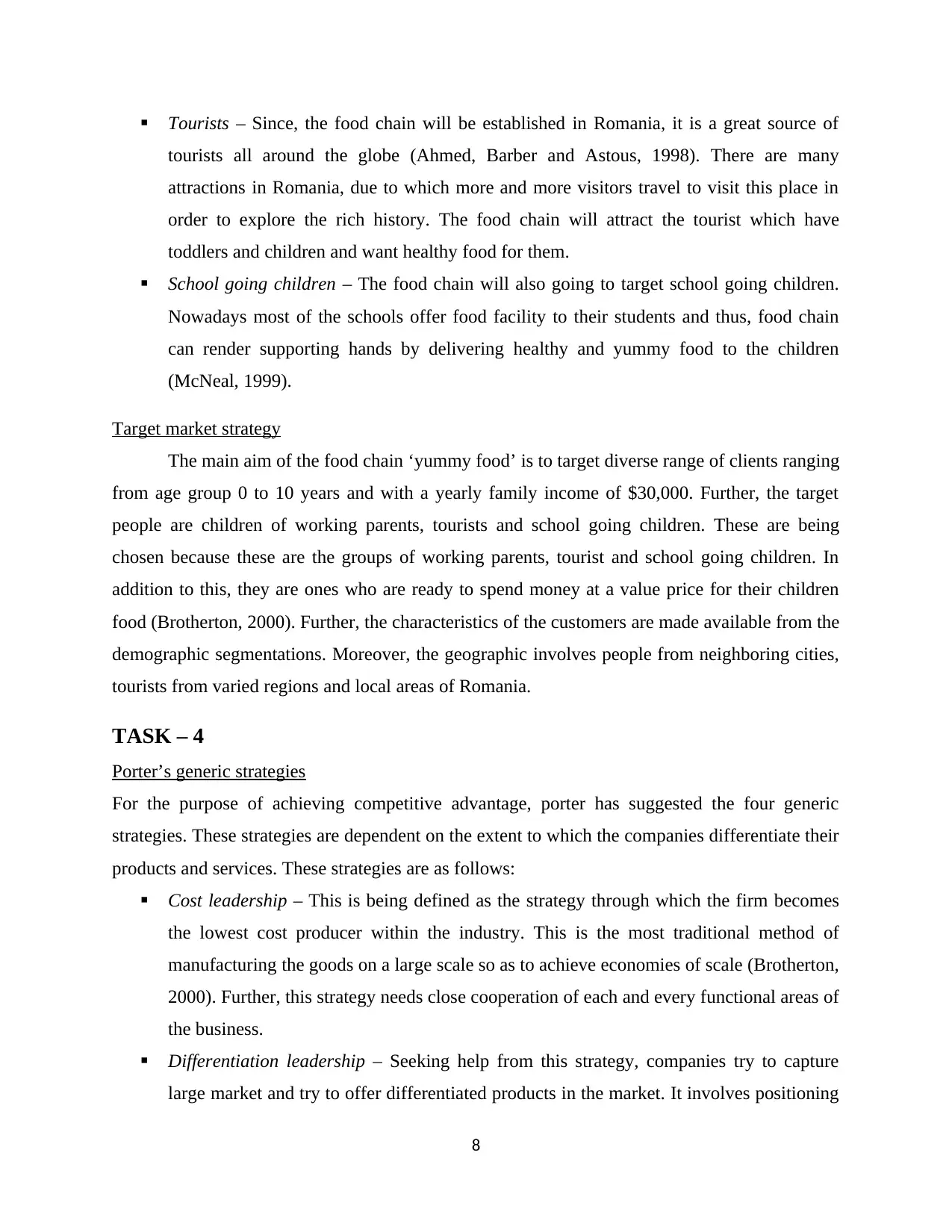
Tourists – Since, the food chain will be established in Romania, it is a great source of
tourists all around the globe (Ahmed, Barber and Astous, 1998). There are many
attractions in Romania, due to which more and more visitors travel to visit this place in
order to explore the rich history. The food chain will attract the tourist which have
toddlers and children and want healthy food for them.
School going children – The food chain will also going to target school going children.
Nowadays most of the schools offer food facility to their students and thus, food chain
can render supporting hands by delivering healthy and yummy food to the children
(McNeal, 1999).
Target market strategy
The main aim of the food chain ‘yummy food’ is to target diverse range of clients ranging
from age group 0 to 10 years and with a yearly family income of $30,000. Further, the target
people are children of working parents, tourists and school going children. These are being
chosen because these are the groups of working parents, tourist and school going children. In
addition to this, they are ones who are ready to spend money at a value price for their children
food (Brotherton, 2000). Further, the characteristics of the customers are made available from the
demographic segmentations. Moreover, the geographic involves people from neighboring cities,
tourists from varied regions and local areas of Romania.
TASK – 4
Porter’s generic strategies
For the purpose of achieving competitive advantage, porter has suggested the four generic
strategies. These strategies are dependent on the extent to which the companies differentiate their
products and services. These strategies are as follows:
Cost leadership – This is being defined as the strategy through which the firm becomes
the lowest cost producer within the industry. This is the most traditional method of
manufacturing the goods on a large scale so as to achieve economies of scale (Brotherton,
2000). Further, this strategy needs close cooperation of each and every functional areas of
the business.
Differentiation leadership – Seeking help from this strategy, companies try to capture
large market and try to offer differentiated products in the market. It involves positioning
8
tourists all around the globe (Ahmed, Barber and Astous, 1998). There are many
attractions in Romania, due to which more and more visitors travel to visit this place in
order to explore the rich history. The food chain will attract the tourist which have
toddlers and children and want healthy food for them.
School going children – The food chain will also going to target school going children.
Nowadays most of the schools offer food facility to their students and thus, food chain
can render supporting hands by delivering healthy and yummy food to the children
(McNeal, 1999).
Target market strategy
The main aim of the food chain ‘yummy food’ is to target diverse range of clients ranging
from age group 0 to 10 years and with a yearly family income of $30,000. Further, the target
people are children of working parents, tourists and school going children. These are being
chosen because these are the groups of working parents, tourist and school going children. In
addition to this, they are ones who are ready to spend money at a value price for their children
food (Brotherton, 2000). Further, the characteristics of the customers are made available from the
demographic segmentations. Moreover, the geographic involves people from neighboring cities,
tourists from varied regions and local areas of Romania.
TASK – 4
Porter’s generic strategies
For the purpose of achieving competitive advantage, porter has suggested the four generic
strategies. These strategies are dependent on the extent to which the companies differentiate their
products and services. These strategies are as follows:
Cost leadership – This is being defined as the strategy through which the firm becomes
the lowest cost producer within the industry. This is the most traditional method of
manufacturing the goods on a large scale so as to achieve economies of scale (Brotherton,
2000). Further, this strategy needs close cooperation of each and every functional areas of
the business.
Differentiation leadership – Seeking help from this strategy, companies try to capture
large market and try to offer differentiated products in the market. It involves positioning
8
Secure Best Marks with AI Grader
Need help grading? Try our AI Grader for instant feedback on your assignments.
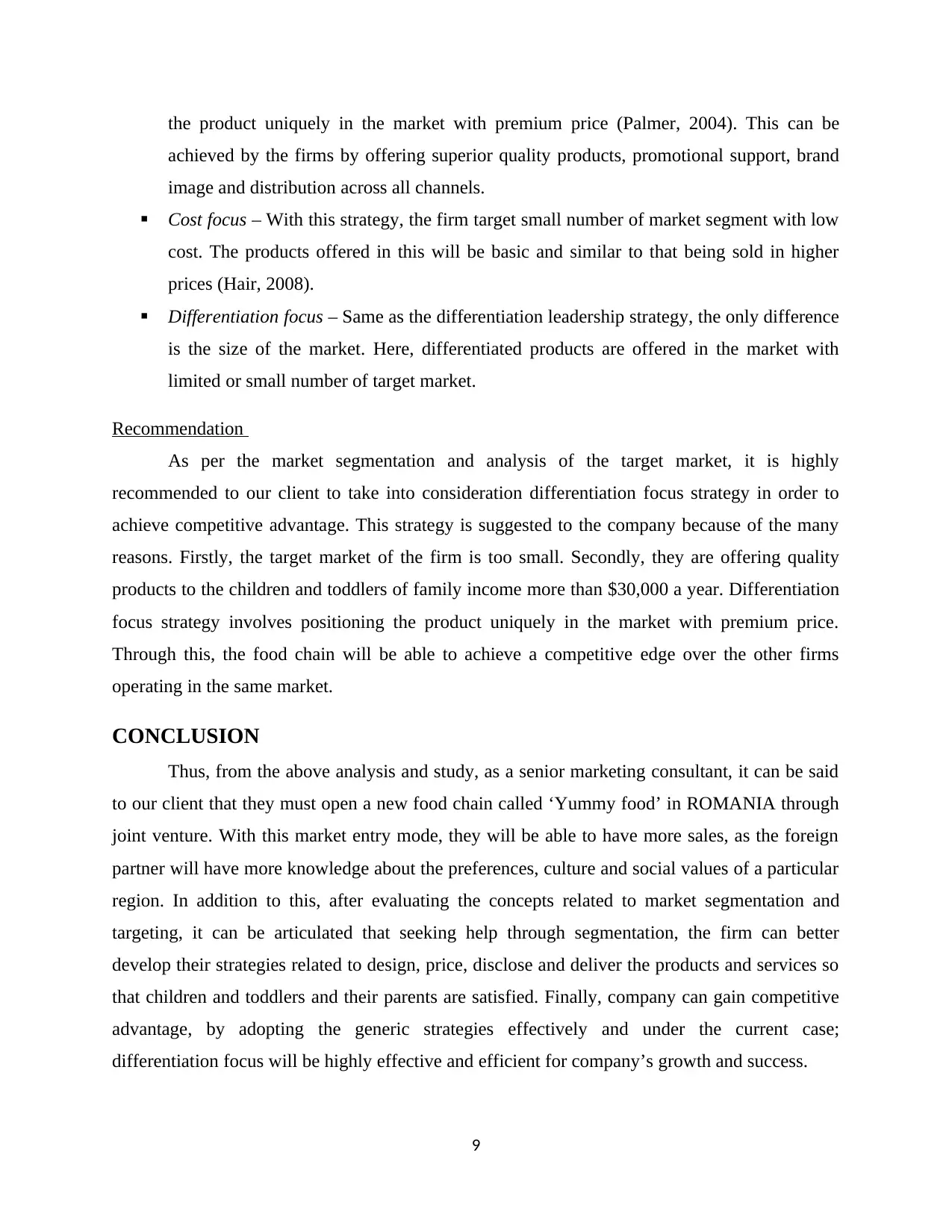
the product uniquely in the market with premium price (Palmer, 2004). This can be
achieved by the firms by offering superior quality products, promotional support, brand
image and distribution across all channels.
Cost focus – With this strategy, the firm target small number of market segment with low
cost. The products offered in this will be basic and similar to that being sold in higher
prices (Hair, 2008).
Differentiation focus – Same as the differentiation leadership strategy, the only difference
is the size of the market. Here, differentiated products are offered in the market with
limited or small number of target market.
Recommendation
As per the market segmentation and analysis of the target market, it is highly
recommended to our client to take into consideration differentiation focus strategy in order to
achieve competitive advantage. This strategy is suggested to the company because of the many
reasons. Firstly, the target market of the firm is too small. Secondly, they are offering quality
products to the children and toddlers of family income more than $30,000 a year. Differentiation
focus strategy involves positioning the product uniquely in the market with premium price.
Through this, the food chain will be able to achieve a competitive edge over the other firms
operating in the same market.
CONCLUSION
Thus, from the above analysis and study, as a senior marketing consultant, it can be said
to our client that they must open a new food chain called ‘Yummy food’ in ROMANIA through
joint venture. With this market entry mode, they will be able to have more sales, as the foreign
partner will have more knowledge about the preferences, culture and social values of a particular
region. In addition to this, after evaluating the concepts related to market segmentation and
targeting, it can be articulated that seeking help through segmentation, the firm can better
develop their strategies related to design, price, disclose and deliver the products and services so
that children and toddlers and their parents are satisfied. Finally, company can gain competitive
advantage, by adopting the generic strategies effectively and under the current case;
differentiation focus will be highly effective and efficient for company’s growth and success.
9
achieved by the firms by offering superior quality products, promotional support, brand
image and distribution across all channels.
Cost focus – With this strategy, the firm target small number of market segment with low
cost. The products offered in this will be basic and similar to that being sold in higher
prices (Hair, 2008).
Differentiation focus – Same as the differentiation leadership strategy, the only difference
is the size of the market. Here, differentiated products are offered in the market with
limited or small number of target market.
Recommendation
As per the market segmentation and analysis of the target market, it is highly
recommended to our client to take into consideration differentiation focus strategy in order to
achieve competitive advantage. This strategy is suggested to the company because of the many
reasons. Firstly, the target market of the firm is too small. Secondly, they are offering quality
products to the children and toddlers of family income more than $30,000 a year. Differentiation
focus strategy involves positioning the product uniquely in the market with premium price.
Through this, the food chain will be able to achieve a competitive edge over the other firms
operating in the same market.
CONCLUSION
Thus, from the above analysis and study, as a senior marketing consultant, it can be said
to our client that they must open a new food chain called ‘Yummy food’ in ROMANIA through
joint venture. With this market entry mode, they will be able to have more sales, as the foreign
partner will have more knowledge about the preferences, culture and social values of a particular
region. In addition to this, after evaluating the concepts related to market segmentation and
targeting, it can be articulated that seeking help through segmentation, the firm can better
develop their strategies related to design, price, disclose and deliver the products and services so
that children and toddlers and their parents are satisfied. Finally, company can gain competitive
advantage, by adopting the generic strategies effectively and under the current case;
differentiation focus will be highly effective and efficient for company’s growth and success.
9
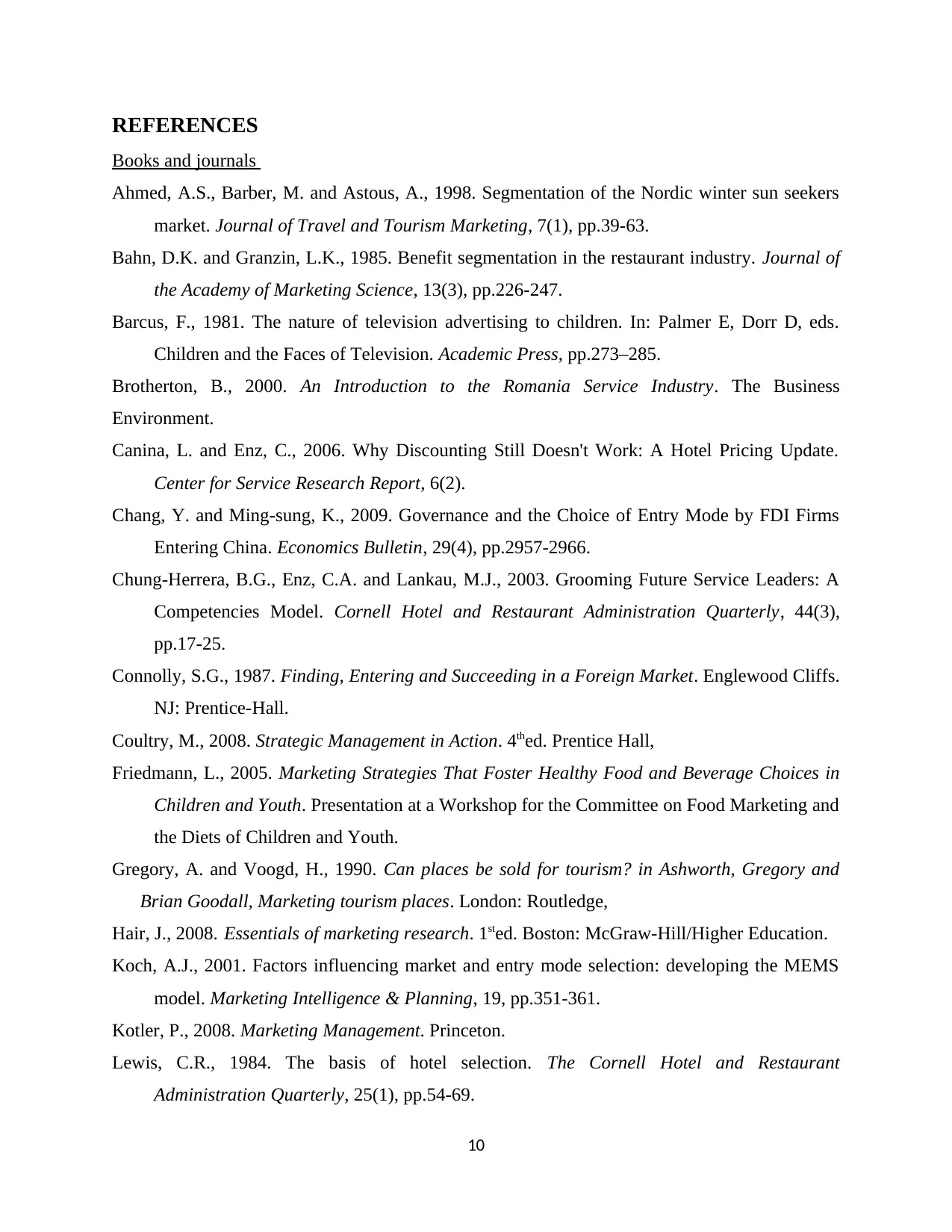
REFERENCES
Books and journals
Ahmed, A.S., Barber, M. and Astous, A., 1998. Segmentation of the Nordic winter sun seekers
market. Journal of Travel and Tourism Marketing, 7(1), pp.39-63.
Bahn, D.K. and Granzin, L.K., 1985. Benefit segmentation in the restaurant industry. Journal of
the Academy of Marketing Science, 13(3), pp.226-247.
Barcus, F., 1981. The nature of television advertising to children. In: Palmer E, Dorr D, eds.
Children and the Faces of Television. Academic Press, pp.273–285.
Brotherton, B., 2000. An Introduction to the Romania Service Industry. The Business
Environment.
Canina, L. and Enz, C., 2006. Why Discounting Still Doesn't Work: A Hotel Pricing Update.
Center for Service Research Report, 6(2).
Chang, Y. and Ming-sung, K., 2009. Governance and the Choice of Entry Mode by FDI Firms
Entering China. Economics Bulletin, 29(4), pp.2957-2966.
Chung-Herrera, B.G., Enz, C.A. and Lankau, M.J., 2003. Grooming Future Service Leaders: A
Competencies Model. Cornell Hotel and Restaurant Administration Quarterly, 44(3),
pp.17-25.
Connolly, S.G., 1987. Finding, Entering and Succeeding in a Foreign Market. Englewood Cliffs.
NJ: Prentice-Hall.
Coultry, M., 2008. Strategic Management in Action. 4thed. Prentice Hall,
Friedmann, L., 2005. Marketing Strategies That Foster Healthy Food and Beverage Choices in
Children and Youth. Presentation at a Workshop for the Committee on Food Marketing and
the Diets of Children and Youth.
Gregory, A. and Voogd, H., 1990. Can places be sold for tourism? in Ashworth, Gregory and
Brian Goodall, Marketing tourism places. London: Routledge,
Hair, J., 2008. Essentials of marketing research. 1sted. Boston: McGraw-Hill/Higher Education.
Koch, A.J., 2001. Factors influencing market and entry mode selection: developing the MEMS
model. Marketing Intelligence & Planning, 19, pp.351-361.
Kotler, P., 2008. Marketing Management. Princeton.
Lewis, C.R., 1984. The basis of hotel selection. The Cornell Hotel and Restaurant
Administration Quarterly, 25(1), pp.54-69.
10
Books and journals
Ahmed, A.S., Barber, M. and Astous, A., 1998. Segmentation of the Nordic winter sun seekers
market. Journal of Travel and Tourism Marketing, 7(1), pp.39-63.
Bahn, D.K. and Granzin, L.K., 1985. Benefit segmentation in the restaurant industry. Journal of
the Academy of Marketing Science, 13(3), pp.226-247.
Barcus, F., 1981. The nature of television advertising to children. In: Palmer E, Dorr D, eds.
Children and the Faces of Television. Academic Press, pp.273–285.
Brotherton, B., 2000. An Introduction to the Romania Service Industry. The Business
Environment.
Canina, L. and Enz, C., 2006. Why Discounting Still Doesn't Work: A Hotel Pricing Update.
Center for Service Research Report, 6(2).
Chang, Y. and Ming-sung, K., 2009. Governance and the Choice of Entry Mode by FDI Firms
Entering China. Economics Bulletin, 29(4), pp.2957-2966.
Chung-Herrera, B.G., Enz, C.A. and Lankau, M.J., 2003. Grooming Future Service Leaders: A
Competencies Model. Cornell Hotel and Restaurant Administration Quarterly, 44(3),
pp.17-25.
Connolly, S.G., 1987. Finding, Entering and Succeeding in a Foreign Market. Englewood Cliffs.
NJ: Prentice-Hall.
Coultry, M., 2008. Strategic Management in Action. 4thed. Prentice Hall,
Friedmann, L., 2005. Marketing Strategies That Foster Healthy Food and Beverage Choices in
Children and Youth. Presentation at a Workshop for the Committee on Food Marketing and
the Diets of Children and Youth.
Gregory, A. and Voogd, H., 1990. Can places be sold for tourism? in Ashworth, Gregory and
Brian Goodall, Marketing tourism places. London: Routledge,
Hair, J., 2008. Essentials of marketing research. 1sted. Boston: McGraw-Hill/Higher Education.
Koch, A.J., 2001. Factors influencing market and entry mode selection: developing the MEMS
model. Marketing Intelligence & Planning, 19, pp.351-361.
Kotler, P., 2008. Marketing Management. Princeton.
Lewis, C.R., 1984. The basis of hotel selection. The Cornell Hotel and Restaurant
Administration Quarterly, 25(1), pp.54-69.
10
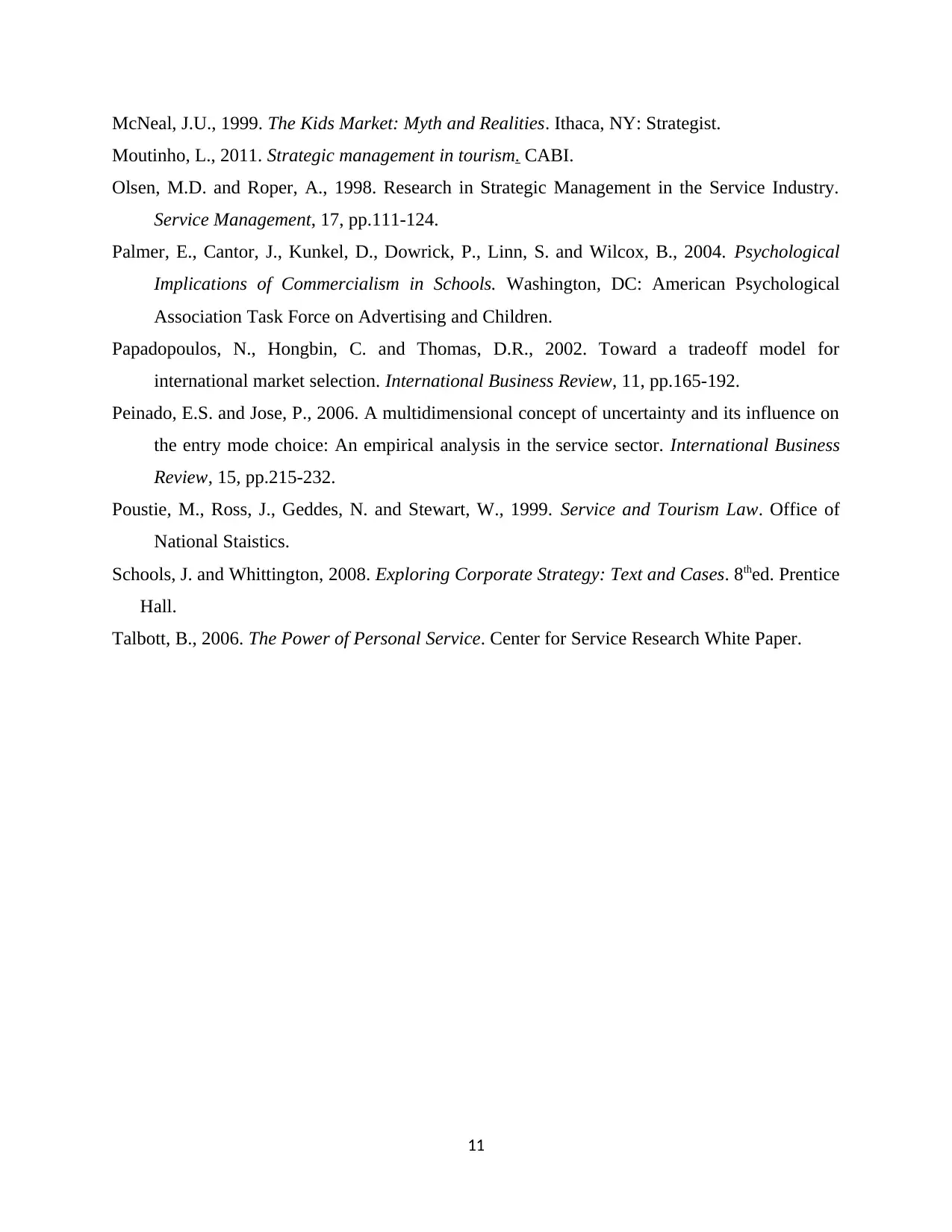
McNeal, J.U., 1999. The Kids Market: Myth and Realities. Ithaca, NY: Strategist.
Moutinho, L., 2011. Strategic management in tourism. CABI.
Olsen, M.D. and Roper, A., 1998. Research in Strategic Management in the Service Industry.
Service Management, 17, pp.111-124.
Palmer, E., Cantor, J., Kunkel, D., Dowrick, P., Linn, S. and Wilcox, B., 2004. Psychological
Implications of Commercialism in Schools. Washington, DC: American Psychological
Association Task Force on Advertising and Children.
Papadopoulos, N., Hongbin, C. and Thomas, D.R., 2002. Toward a tradeoff model for
international market selection. International Business Review, 11, pp.165-192.
Peinado, E.S. and Jose, P., 2006. A multidimensional concept of uncertainty and its influence on
the entry mode choice: An empirical analysis in the service sector. International Business
Review, 15, pp.215-232.
Poustie, M., Ross, J., Geddes, N. and Stewart, W., 1999. Service and Tourism Law. Office of
National Staistics.
Schools, J. and Whittington, 2008. Exploring Corporate Strategy: Text and Cases. 8thed. Prentice
Hall.
Talbott, B., 2006. The Power of Personal Service. Center for Service Research White Paper.
11
Moutinho, L., 2011. Strategic management in tourism. CABI.
Olsen, M.D. and Roper, A., 1998. Research in Strategic Management in the Service Industry.
Service Management, 17, pp.111-124.
Palmer, E., Cantor, J., Kunkel, D., Dowrick, P., Linn, S. and Wilcox, B., 2004. Psychological
Implications of Commercialism in Schools. Washington, DC: American Psychological
Association Task Force on Advertising and Children.
Papadopoulos, N., Hongbin, C. and Thomas, D.R., 2002. Toward a tradeoff model for
international market selection. International Business Review, 11, pp.165-192.
Peinado, E.S. and Jose, P., 2006. A multidimensional concept of uncertainty and its influence on
the entry mode choice: An empirical analysis in the service sector. International Business
Review, 15, pp.215-232.
Poustie, M., Ross, J., Geddes, N. and Stewart, W., 1999. Service and Tourism Law. Office of
National Staistics.
Schools, J. and Whittington, 2008. Exploring Corporate Strategy: Text and Cases. 8thed. Prentice
Hall.
Talbott, B., 2006. The Power of Personal Service. Center for Service Research White Paper.
11
1 out of 13
Related Documents
Your All-in-One AI-Powered Toolkit for Academic Success.
+13062052269
info@desklib.com
Available 24*7 on WhatsApp / Email
![[object Object]](/_next/static/media/star-bottom.7253800d.svg)
Unlock your academic potential
© 2024 | Zucol Services PVT LTD | All rights reserved.





